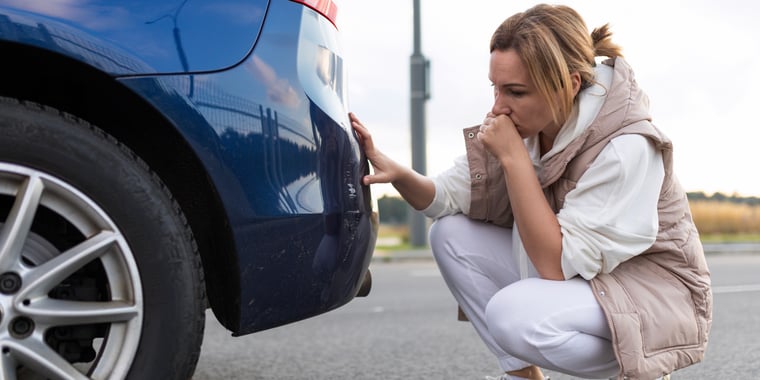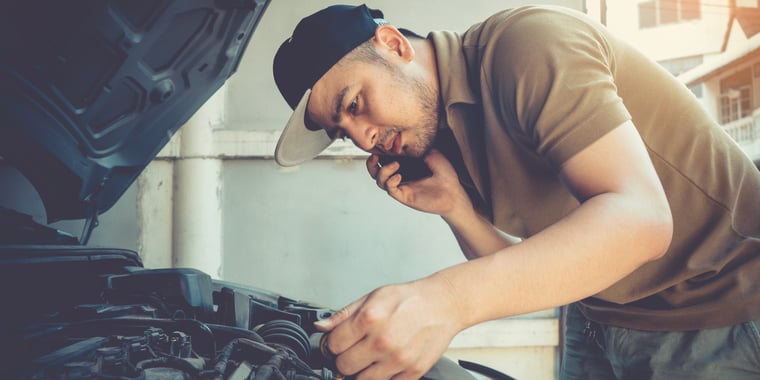Can I Repair a Leased Vehicle by Myself?
So, your leased car is damaged. Most lease contracts include coverage for approved, predictable maintenance, but usually won’t cover damage from accidents (like, say, a mailbox that appeared out of thin air). If you’d rather avoid disclosing the damage, or just like to work on your own cars, you might be wondering – can I repair a leased vehicle myself?
What Happens If I Damage My Leased Car?
So, how do you deal with a damaged leased car? We’ve actually already covered a lot of this info in another article of ours – it’s about what to do if you crash a leased car, but the steps are more or less the same in this case. Basically, you’ll want to start by contacting your insurance provider, and then you’ll want to review your lease contract for approved maintenance providers. If you have any questions about what’s approved and what’s not, you’ll want to contact your dealership or lender for the most accurate info.
Another note – most of the info in this article covers damage like a dented bumper, scratches, mirror issues, etc. If you’ve been in a crash and your car is totaled, you’ll need to rely on your GAP coverage (which usually comes with every lease contract) and contact your dealership or manufacturer to coordinate your next steps.
Can I Return a Leased Car with Damage?
Technically, yes, you can return a leased car that’s damaged – but it’s not advised.
When you turn your leased car back in, they’ll do a vehicle inspection and can charge you wear-and-tear fees depending on the extent of the damage to your car. This could be anything from a small scratch to a major dent – and the bigger the damage, the bigger the cost. Generally, it’s best practice for you (and your wallet) to coordinate repairs on any major damage to the car before you return the leased car, which will at least allow you a bit of control over when and where those costs come.
If you’re nearing the end of your lease and want to minimize surprises, most dealerships will allow you to schedule a pre-inspection (or you can look for a third-party inspection service for a less-biased opinion). If you plan for one, someone can look over the state of your car before lease-end and point out any potential charges. If you want to try it at home, some manufacturers provide lease-damage guides like this one from Ford that allow you to do a kind of pre-inspection yourself to assess the damage on your car. That way you'll see if, for example, you should fix that one dent on your leased car or if it’s not worth the sweat.
Where Can I Take My Leased Car for Repair?
We can’t give you a name, but we can tell you where to find this info: in your lease contract (or by contacting your dealership or lender). Coverage plans for leased cars will usually stipulate where you can get work done on your vehicle, so you’ll need to check on those requirements before scheduling a repair just anywhere.
Can I Repair My Leased Vehicle By Myself?
You can, in the same way that you can return a leased car with damage – free will does allow you this option, but it’s not advised. If you do your own repairs, depending on the damage done and how well it was repaired, there’s always a chance that your dealership will never know anything happened. However, we don’t recommend the ‘under the radar’ strategy for repairs.
For one, dealerships can charge you for damage and “mishandled” repairs. Since they have a financial incentive to catch you on anything like this, you can bet they’ll be looking hard for evidence. Additionally, if you do your own repairs instead of coordinating with the dealership, they may charge you even more to have the damage assessed and fixed again by their own approved people.
So, you could technically repair your leased vehicle by yourself, but only if you’re willing to accept the costs of paying for the repair twice: once on your own, and potentially again when turning your leased car back in.
Not planning on turning your leased car back in? You’re not alone, and we can help you with that. Skip to the end of this article, visit leaseend.com, or call us at (844) 902-2842 if you’re ready to start talking about your lease-end options that don’t involve a traditional turn-in.
Can You Change Parts on a Leased Car?
What we’re saying applies to part replacements, too, not just cosmetic damage. Any parts not OEM-approved (OEM is the Original Equipment Manufacturer, like Honda) will likely be penalized at turn-in, so it’s best not to try the ol’ switcheroo and hope your dealer doesn’t notice at turn-in.
What Does it Cost to Repair a Leased Vehicle?
Costs to repair a leased vehicle will depend on a) the type of damage and b) the severity of the damage. If the damage or maintenance is covered under your lease contract or manufacturer’s warranty, you shouldn’t see any extra costs. If not, though, it’ll come out-of-pocket for you, with the cost varying depending on the details of the damage
Who Pays for Damage on a Leased Car?
Expected maintenance, like oil changes, tire replacement, etc., is often covered by a lease contract, either as a standard term or as an additional purchase at the time of leasing, or by manufacturer warranty. Repairs due to things like crashes, accidents, or accidental internal damage is usually not covered. These unexpected repairs shouldn’t cost you much more than they would on a car you own, the major difference being that, if you own the car, you likely have many more options on where you could get the issue addressed. Again, to confirm this information for sure, make sure to check your leased contact.
Don’t forget that you can utilize your car insurance on your leased car more or less the same way you would on a car you own. If a repair is covered by your insurance, they may be able to help with the cost as well – just keep your deductible in mind.

Let's Wrap It Up
Can you repair your leased car by yourself? We can wrap up this article the way we have to conclude many other articles about leasing – with a big, fat it depends. If you run into some damage with your leased car and want to take care of repairs yourself, more power to you. Just be prepared to pay up (potentially big time) when it comes time to turn your leased car in.
But let’s say you’re dreading turn-in. Do you have any other options? As luck would have it, you do. Lease End assists drivers who want to keep their leased car. If you’re looking to keep your leased car in your life, we can help you buy it out. We’ll secure a loan to pay off and buy out your leased vehicle, and you can finance that loan to continue making payments on your car – except this time, it’s yours.
We don’t require vehicle inspections, so if you’ve got some damage you’d rather not deal with through the dealership (or if you’re over on your mileage allowance and trying to avoid those fees), you won’t need to fess up to us – or do. We won’t judge you.
Check us out at leaseend.com to learn more or give us a call at (888) 307-5197 to have a no-pressure chat with one of our expert advisors about your lease-end options. When you're ready, get started by entering your license plate or VIN below.
Enter Your License Plate to Get Started.
Enter Your License Plate to Get Started.


